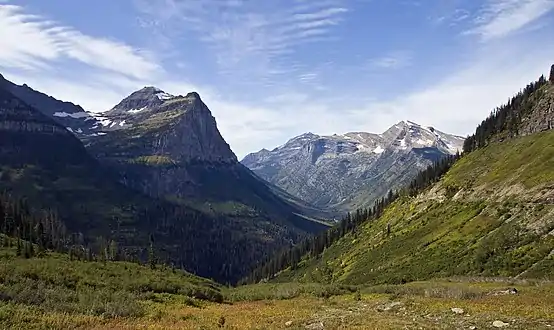Mount Cannon
Mount Cannon (8,956 feet (2,730 m)) is located in the Lewis Range, Glacier National Park in the U.S. state of Montana.[3] Formerly called Goat Mountain it was renamed for the leading physiologist Dr. Walter Bradford Cannon and his wife Cornelia, who made the first recorded ascent of the mountain in 1901.[4]
| Mount Cannon | |
|---|---|
 Mount Cannon seen from Going-to-the-Sun Road | |
| Highest point | |
| Elevation | 8,956 ft (2,730 m) [1] NAVD 88 |
| Prominence | 1,792 ft (546 m) [1] |
| Coordinates | 48°41′33″N 113°46′27″W [2] |
| Geography | |
 Mount Cannon Location in Montana  Mount Cannon Location in the United States | |
| Location | Flathead County, Montana, U.S. |
| Parent range | Lewis Range |
| Topo map | USGS Mount Cannon, MT |
| Climbing | |
| First ascent | 1923 Norman Clyde[1] |
Geology
Like other mountains in Glacier National Park, Cannon is composed of sedimentary rock laid down during the Precambrian to Jurassic periods. Formed in shallow seas, this sedimentary rock was initially uplifted beginning 170 million years ago when the Lewis Overthrust fault pushed an enormous slab of precambrian rocks 3 mi (4.8 km) thick, 50 miles (80 km) wide and 160 miles (260 km) long over younger rock of the cretaceous period.[5]
Climate
Based on the Köppen climate classification, Cannon is located in a subarctic climate characterized by long, usually very cold winters, and short, cool to mild summers.[6] Temperatures can drop below −10 °F with wind chill factors below −30 °F.
See also
References
- "Mount Cannon, Montana". Peakbagger.com. Retrieved 2010-08-14.
- "Mount Cannon". Geographic Names Information System. United States Geological Survey. Retrieved 2010-08-14.
- Mount Cannon, MT (Map). TopoQwest (United States Geological Survey Maps). Retrieved June 4, 2018.
- Fred Spicker, Moni (Jun 19, 2011). "Mount Cannon (MT)". SummitPost. Retrieved May 10, 2012.
- Gadd, Ben (2008). "Geology of the Rocky Mountains and Columbias". Cite journal requires
|journal=(help) - Peel, M. C.; Finlayson, B. L.; McMahon, T. A. (2007). "Updated world map of the Köppen−Geiger climate classification". Hydrol. Earth Syst. Sci. 11: 1633–1644. ISSN 1027-5606.
Gallery
 Mount Cannon by Ansel Adams
Mount Cannon by Ansel Adams.jpg.webp) Mount Cannon (right) seen from Lake McDonald
Mount Cannon (right) seen from Lake McDonald Mount Cannon at center left rises above the McDonald Valley
Mount Cannon at center left rises above the McDonald Valley